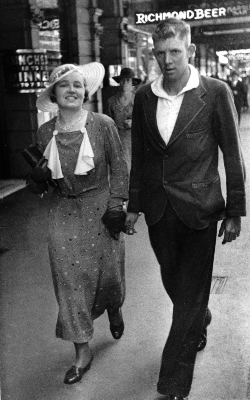Quilt No.759PHM - Powerhouse Museum
1660 x 1610mm
The quilt was made by Mrs Kathleen (Kitty) Parker at Woonona, NSW, in early 1936 . She was born Kathleen Ward in 1913 in Coledale on the south coast of NSW. The quilt was made for her husband William Parker and was kept in the family. Kathleen Parker donated it to the Powerhouse Museum.
"Kathleen met her husband William Parker in 1933 during a queen competition for the Woonona School of Arts and Ambulance. She was a candidate for the competition and says 'I had a wonderful but busy 3 months and won a gold watch which is still working today'.
Bill (who was born in Mt Kembla) and Kathleen (Kit, as her husband called her) were married in 1935 at St. Paul's Church of England, Woonona. The quilt was made soon after their wedding. Bill and Kit went to live in Corrimal where Bill owned his own grocery store and was later a coal miner. They had one daughter." [PHM]
In 1985 Kathleen Parker wrote to the Powerhouse Museum:
"I have a Wagga Rug which I made for my husband in 1935 (just after I was married) to take to Robertson camping and rabbiting. I didn't want to use my new blankets so made the rug using ideas I had heard my grandmother talking about years earlier. It has 3 corn bags opened and stitched together and covered with pieces cut from old coats and trousers stitched together (by machine for quickness) and some cotton material on the other side.
"Years ago I think most people in our area had heard about my husband's Wagga Rug as he was so proud of it and used it until he passed away 10 years ago. It is not an elegant thing, slightly water stained��.There's quite a story about it as the patches were cut from clothes stored in my Mother-in-law's laundry, kept for patches on borders' work clothes. My brother bought me an old second-hand Singer treadle sewing machine with box top and I had fun using it to sew the patches together.
"Rabbiting and camping were only hobbies for Bill, his main one being homing pigeons which he had all his life. He had horses for years and hired them out at a riding school at Windang Camping area during holidays, and always took the wagga. Friends and neighbours over the years had heard him speak of his old wagga many times and he used it consistently until 1974 when he passed away. He thought so much of [it] because no-one else had one.
"As near as I can remember I made it early 1936, really as a novelty, and as a new bride wanted to make something to please him and also to save my new blankets. I remember re-lining it some years ago , but can't recall the original lining, but maybe it was unbleached calico flour bags.
"I think it took about a week to make and although I had never seen one, my paternal garndmother, who later moved to Newcastle, told me how they were made when she was young. I think the practice had long since ceased as by then they seemed to be more financial than in the days when from necessity they had to be thrifty."
[Kathleen Parker for the Powerhouse Museum 1985]

Related Quilts:
1270 x 1160mm
2057 x 1220mm






